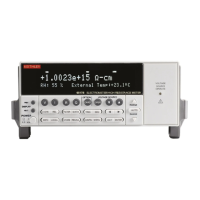Model 6517B Electrometer Reference Manual Section 3: Connections
6517B-901-01 Rev. C / August 2015 3-15
Handling and cleaning test fixtures
Dust, body oil, solder flux, and other contaminants on connector and terminal insulators can
significantly decrease the leakage resistance resulting in excessive leakage currents. Also,
contaminants on DUT and test circuit components can create a leakage path. These leakage currents
may be large enough to corrupt low-level measurements.
Handling tips:
Do not touch the bodies of DUT or test circuit components. If you cannot handle them only by
their leads, use clean cotton gloves to install them in the test fixture.
Do not touch any connector or terminal insulator.
If installing a test circuit that is on a pc-board, handle the board only by the edges; do not touch
any board traces or components.
Cleaning tips:
Use dry nitrogen gas to clean dust off of connector and terminal insulators, DUT, and other test
circuit components.
If you have just built the test fixture, remove any solder flux using methanol along with clean
foam-tipped swabs or a clean soft brush.
To clean contaminated areas, use methanol and clean foam-tipped swabs. After cleaning a large
area, you may want to flush the area with methanol. Blow dry the test fixture with dry nitrogen
gas.
After cleaning, the test fixture (and any other cleaned devices or test circuits) should be allowed
to dry in a 50°C low-humidity environment for several hours.

